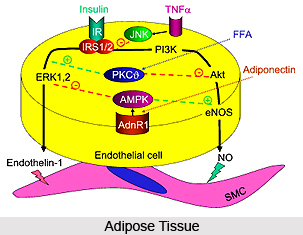 The unique feature of Ayurvedic physiology is that each human tissue is derived from the previous tissue in ascending order of complexity. So chronologically speaking, from rasa (life sap) the body builds up rakta (blood), from rakta it develops mansa (muscles) and from this mansa originates meda ( adipose tissue).
The unique feature of Ayurvedic physiology is that each human tissue is derived from the previous tissue in ascending order of complexity. So chronologically speaking, from rasa (life sap) the body builds up rakta (blood), from rakta it develops mansa (muscles) and from this mansa originates meda ( adipose tissue).
Obesity in humans and most animals is dependent upon the amount of body fat-specifically adipose tissue rather than on the amount of body weight. Adipose tissue also serves as an important endocrine organ by producing certain hormones like leptin, resistin.
Meda or adipose tissue is a kind of connective tissue that is characterized by the presence of free fat inside the fat cells. These cells remain supported by a loose framework of areolar tissue, which is another type of connective tissue.
Blood vessels and lymphatics (duct like structures) pass along the loose framework. The cells are generally large, rounded or oval in shape. They may assume a polyhedral shape due to pressure of the adjacent fat cells. The big fat droplets occupy the whole of the cell. The cytoplasm and the flattened nucleus are pushed out to one side.
Due to such an arrangement, the cell gives the appearance of a `signet` ring. The cells are said to contain special enzymes, which help in the deposition of fat. Two types of adipose tissue exist: white adipose tissue (WAT) which comprises the bulk of body`s fat reserves and brown adipose tissue (BAT) which is much more restricted in its distribution.
Meda remains distributed in many places and are specially found in the so-called fat depots like `omentum`, `subcutaneous tissue`, `mesentery and perinephric region`, and `subpericardial tissue`. Yellow bone marrow is very rich in fat. Fat is present in large amounts in the lactating mammary glands. Adipose tissue is absent in eyelids, in some parts of sexual organs, cavity of cranium and certain portions of lungs. In a person with severe obesity, excess adipose tissue is found to hang downwards from the abdomen. In scientific terms, such structures are referred to as panniculus (or pannus).
The panniculus often poses great problems if the obese person requires surgery. The panniculus may remain as an abnormal outgrowth colloquially termed as "apron of skin" if a severely obese person loses large amounts of weight in a very short span of time. This condition cannot be corrected through diet and exercise, but needs plastic surgery.
Meda serves a variety of functions. Remaining under the body surface, it gives shape to the limbs and body. The adipose tissue that remains around the viscera keeps the visceral organs in position and prevents injury. Other functions include playing a role in the regulation of body temperature and acting as the storehouse of energy.
Thus we see that some amount of meda is essential for the body as it assists in the regular bodily activities. But an excess of fat creates a variety of problems and hampers normal life. Ashtang Ayurveda suggests proper diet and certain yogic therapies for maintaining the body in proper shape by getting rid of excess meda.





